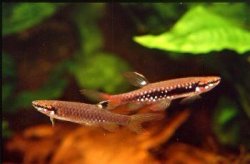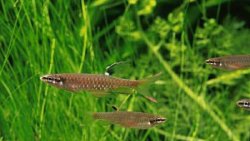Anybody have experience with these fish? I have been reading up on them and they seem really interesting. Especially their spawning behavior. Recommended?
You are using an out of date browser. It may not display this or other websites correctly.
You should upgrade or use an alternative browser.
You should upgrade or use an alternative browser.
Splashing tetras
- Thread starter JuiceBox52
- Start date
The October FOTM Contest Poll is open!

🏆 Click to vote! 🏆
I had a group many years ago. They are not seen up here, but you should be able to get them (in season) from The Wet Spot in Portland. The true Splashing Tetra, Copella arnoldi, is fascinating, and here an aquarium half filled with water is needed, with emersed plants providing leaves above the water surface. A sort of vivarium, as it should still be covered to keep the air above the water warm and moist.
This fish is closely related to the pencilfishes so they are not "tetras" as such, but in the same Order, characiformes. The following info for those unfamiliar with these fishes.
Truly an unique characin in its method of spawning. The male and female pair will jump from the water and cling to the underside of an overhanging leaf for a few seconds, during which the eggs are deposited and fertilized; the parents release themselves and drop back into the water. This procedure is repeated several times until 150 to 200 eggs have been laid. The male then remains under the leaf, periodically splashing water onto the eggs to prevent them from drying out. The eggs hatch in 2-3 days and drop into the water.
There is some variation in the pattern and colouring among fish from different locales, as illustrated in the two photos. Males are larger, with elongated fins and brighter colouring; in both photos, the male fish is above the female.
To allow for spawning, the tank should have space above the water surface for overhanging plant leaves, either from aquatic plants that grow above the water such as Echinodorus macrophyllus, or house plants allowed to grow over the tank. The tank must still be either covered or the water level must be low enough to prevent the fish from escaping the tank, since they are surface fish and avid jumpers. Floating plants are also recommended to provide a sense of security, along with dim lighting. The mouth is upturned, termed "superior," typical of surface-dwelling fish.
Origin and Habitat: Guyana, French Guyana, Suriname and Brazil. Occurs in slower-moving feeder tributary streams and creeks with overhanging vegetation.
Originally described as Copeina arnoldi by Regan (1912), the species was one of 11 in the genus. In 1956, Dr. George S. Meyers erected the genus Copella for three of the species, but all but two species were subsequently moved into the new genus (Gery, 1977). The Sub-Family Pyrrhulininae now contains two tribes, the Pyrrhulinini containing the genera Copeina (2 species), Copella (9 species) and Pyrrhulina (18 species), and the Nannostomini tribe of the closely-related pencilfishes in the genus Nannostomus. The adipose fin is never present and the mouth is superior in the Pyrrhulinini, whereas the mouth is terminal in the Nannostomini and the adipose fin is sometimes present.
This fish is closely related to the pencilfishes so they are not "tetras" as such, but in the same Order, characiformes. The following info for those unfamiliar with these fishes.
Truly an unique characin in its method of spawning. The male and female pair will jump from the water and cling to the underside of an overhanging leaf for a few seconds, during which the eggs are deposited and fertilized; the parents release themselves and drop back into the water. This procedure is repeated several times until 150 to 200 eggs have been laid. The male then remains under the leaf, periodically splashing water onto the eggs to prevent them from drying out. The eggs hatch in 2-3 days and drop into the water.
There is some variation in the pattern and colouring among fish from different locales, as illustrated in the two photos. Males are larger, with elongated fins and brighter colouring; in both photos, the male fish is above the female.
To allow for spawning, the tank should have space above the water surface for overhanging plant leaves, either from aquatic plants that grow above the water such as Echinodorus macrophyllus, or house plants allowed to grow over the tank. The tank must still be either covered or the water level must be low enough to prevent the fish from escaping the tank, since they are surface fish and avid jumpers. Floating plants are also recommended to provide a sense of security, along with dim lighting. The mouth is upturned, termed "superior," typical of surface-dwelling fish.
Origin and Habitat: Guyana, French Guyana, Suriname and Brazil. Occurs in slower-moving feeder tributary streams and creeks with overhanging vegetation.
Originally described as Copeina arnoldi by Regan (1912), the species was one of 11 in the genus. In 1956, Dr. George S. Meyers erected the genus Copella for three of the species, but all but two species were subsequently moved into the new genus (Gery, 1977). The Sub-Family Pyrrhulininae now contains two tribes, the Pyrrhulinini containing the genera Copeina (2 species), Copella (9 species) and Pyrrhulina (18 species), and the Nannostomini tribe of the closely-related pencilfishes in the genus Nannostomus. The adipose fin is never present and the mouth is superior in the Pyrrhulinini, whereas the mouth is terminal in the Nannostomini and the adipose fin is sometimes present.
Attachments
Often admired them in Fish Stores but never kept them, reading that I might have a try if I see them again.
I should have posted this previously. It is an excerpt from a BBC nature documentary on the Amazon and this sequence shows the spawning and egg care. Another of nature's incredible marvels.
That is a really cool clip. Makes me want them more!I should have posted this previously. It is an excerpt from a BBC nature documentary on the Amazon and this sequence shows the spawning and egg care. Another of nature's incredible marvels.
I showed it to my mom and she thinks in weird... I'm the weird animal child. She'll have a break when I move out. Until then I must keep begging for more pets
Retired Viking
Fish Connoisseur
That is awesome, never seen a fish do that before.

Splashing tetras are cool but need a single species tank or a tank with small peaceful bottom dwellers. Byron has covered most of it.
I kept mine in a 3 foot long tank with lots of plants. They were fed a variety of dry, frozen and live foods and did reasonably well. There's a number of different species and they are all worth keeping and breeding just to stop them becoming extinct in the wild.
They are worth keeping if you can get them
I kept mine in a 3 foot long tank with lots of plants. They were fed a variety of dry, frozen and live foods and did reasonably well. There's a number of different species and they are all worth keeping and breeding just to stop them becoming extinct in the wild.
They are worth keeping if you can get them
I had them before they die of cyst on mouth, they have the same problems with neon and cardinal “mouth cyst problem”. I have tried to do a surgery on them but didnt live.
Similar threads
- Replies
- 26
- Views
- 508



